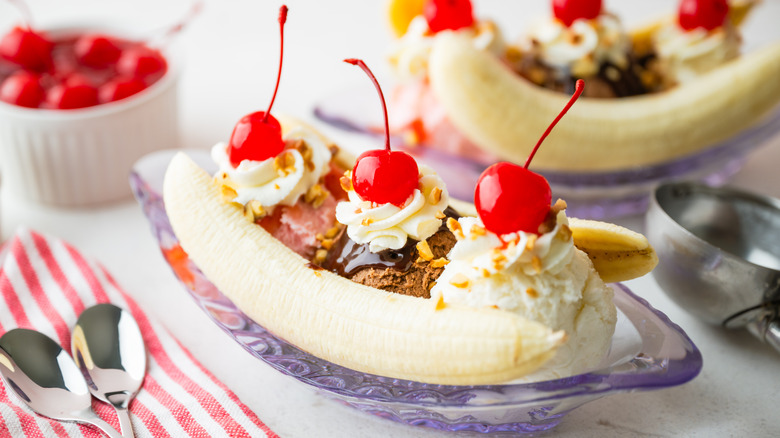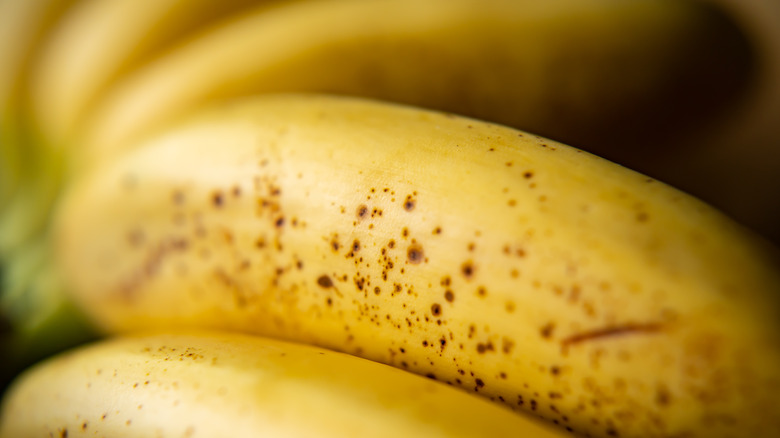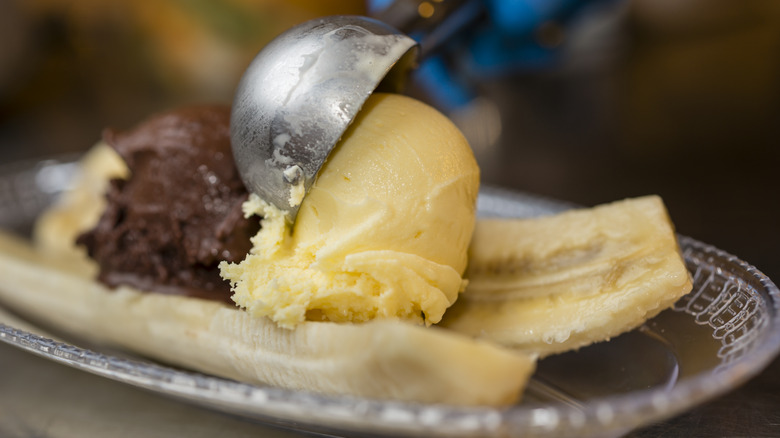Follow The Freckle Rule For Perfect Banana Splits
The banana split has been a darling of the American dessert scene since its conception in 1904 by David Strickler. Strickler worked as a soda jerk — a person who served ice cream and beverages at a soda fountain — at Tassell Pharmacy in Latrobe, Pennsylvania. It is here that he reportedly created the very first version of this treat from a sliced banana, topped with three scoops of ice cream (vanilla, chocolate, and strawberry), assorted garnishes, and whipped cream.
The basic recipe for a banana split remains much the same today, though a dessert as deliciously simple as this has lent itself to countless flavor combinations, both with the ice cream itself and with the toppings. One thing that certainly isn't up for change, however, is the fruit of its namesake — the banana. Finding the best banana for the job is crucial to a mouthwatering split, so here's what you're looking for: Not the shiny, vibrant banana you might think, but rather their slightly spotted or "freckled" peers.
Why you should choose spotty bananas for banana splits
Bananas with a sprinkling of brown spots are slightly sweeter than their more aesthetically pleasing counterparts, making them the perfect choice for the flavors of a banana split. This is because as the fruit ages, the starch inside of it is converted into sugar, and it's this process that causes blemishes on the skin. That said, you can essentially gauge how sweet a banana is by how many spots it has. And while these little freckles may not look the most attractive, rest assured that the fruit hiding behind them is perfectly safe to eat (the same can be said for bananas with black markings). In fact, the only time you should steer clear of a blemished banana, brown spots or otherwise, is if it has a strange smell or is moldy or slimy.
And while brown spots certainly get the green light for your banana split, mushy bananas definitely don't. The more blemished a banana is, the softer it is. Banana splits call for fruit that still has some firmness to it, and can retain its shape when cut in two. For this reason, you should stick to bananas with just a light smattering of freckles, rather than those that are covered in them — the latter should be strictly reserved for use in baked treats like classic banana muffins, or this epic banana bread from Martha Stewart.
More banana split tips
On top of choosing freckly fruit, there are some other things you can do to help make your banana split the pick of the bunch. Start by popping your blemished bananas in the refrigerator. This halts the ripening process for a few days, and will also give you a much nicer mouthfeel when paired with the coolness of the ice cream, whipped cream, and other ingredients in the dish than a banana straight from the fruit bowl would.
When the time to dish up your banana split finally arrives, you can either cut the ends off the fruit first (this gives a tidier finish while also removing that strange brown stub at one end, which is actually the flower the banana first grew from) or leave them as is, before peeling and cutting the fruit in half. Either way, be sure to make use of the resulting peel with these inspired banana peel tips. And as obvious as it might sound, don't forget to use a sharp knife — this is imperative in giving you that classic, clean, two-slice look. Now all that's left to do is load the fruit with whatever ice cream and toppings your heart desires. Go bananas!


